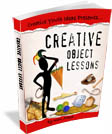This week’s idea of the week centers around the drinking straw. The main lesson reminds youth that what sometimes what we see as impossible is not always as impossible as it seems.
PLEASE SHARE THIS IDEA ON FACEBOOK – CLICK HERE
What You Need
- Lots of soda straws for games
- Depending on the games chosen, various games may require additional resources
- Apples or potatoes for the final object lesson
Games using Straws
- Candy Pass – This game can be played with drinking straws and any candy that has a hole in it that is big enough to slide onto a straw. (Lifesavers or Polo mints usually work fine.) Each team stand in a line and with straws in their mouths they must thread the candy onto the straw then successfully pass it from straw to straw until it reaches the end of the line. First team to do so wins. To make the game last longer, give them a whole roll of candies to pass. (You can also use washers, paperclips or rubber bands to pass) (Make it more interesting by blindfolding one person in the middle of each team) If the diameter of the straws is a problem, use coffee straws for this game.
- Jello Slurp – Give each team a bowl of Jello and using straws, the first team to slurp up the jello wins
- Peas and Straws – Give each team a cup containing twenty peas and an empty cup as well. Each team selects a champion to compete on their behalf. At a signal, all the players must compete to be the first to transfer the peas from one cup to the other using only the straw. They may not touch the cup or peas with anything except the straw. (Note: there is nothing in the rules to stop players from bending the straw in half and using it like a pair of tweezers.) (Note: You can also use skittles or M&Ms)
- Pick up Sticks – Using straws, play a classic game of pickup sticks. Divide the youth into two teams. Hold a fist full of straws upright and then remove your hand and let them drop into one big messy pile. Players from each team will take turns to carefully pull a straw from the pile without moving any other straws. If he or she is successful, the player keeps the straw and can go again. However, if any of the other straws move in the process of removing one the turn ends for that team. The team with the most straws at the end wins. You can find detailed directions here: http://en.wikipedia.org/wiki/Pick-up_sticks
- Pingpong ball Soccer – Clear a table (a ping pong table works great) and place pencils at either end as the goals. Give everyone a drinking straw and then divide the youth into two teams. Players must position themselves around the table so that no two teammates are standing next to each other. Place the ping pong ball in the center of the table and then the teams try to blow jets of air through the straws to move the ball so that it hits one of the pencil goals to score. If the ball flies off the table, simply replace it back on the table at the place where it went out. No shoving, pushing, or use of hands is allowed. First team to make it to a designated number of points wins.
- Pipeline – Give all the youth straws and then divide them into teams of 8 to 20 persons. Each team designates a sipper at the far end. At signal they must join the straws together to create a pipeline and the sipper must drink all the coke from a cup. (It’s not as easy as it seems because air leaks from the connections between the straws)
- Plastic straw Javelin – Youth stand behind a line and flip or throw the straw as far as possible. Farthest toss wins. (Note: Straws may not be torn, folded, bent or changes in anyway not can anything be placed inside the straw.)
- Puzzler – Using a small jigsaw puzzle for each team (You can usually find some with less than 50 pieces), youth must put the puzzle together using only straws in their mouths. They may not touch the pieces with their hands. First to complete the puzzle wins. (Alternatively you can cut a photograph, postcard, or greeting card into pieces)
- Q-Tip War – Divide the room in half for two teams or if you want four teams divide it into quarters. A piece of strong or masking tape on the floor can be a simple divider. Give everyone a straw and each team a package of q-tips. Youth will use the straw to wildly shoot the q-tips like poisoned darts across the room until time is up. When the time is up, the team who has the least number of q-tips in their area wins. Q-tips may not be thrown and players cannot leave their area.
- Straw & Paper – Divide the youth into teams, with team members lines up single file, one behind the other, and give everyone on the team a plastic straw. The first player must place the straw in his or her mouth and use the straw to carry a piece of tissue to a finish line and then back to his or her team. No hands are allowed. If the tissue drops, they must get it back on the straw, by sucking in through the straw, before moving on. The first team to have everyone on the team complete the relay wins.
- Straw Chomp – Each team chooses a champion to represent them who will be given a straw. The first person to get the entire straw in his or her mouth without using hands wins. It’s harder than you think.
- Straws and Rubberband mixer – All the youth are given straws to hold in their mouth and half of them are given rubber bands to hang on the straws. The youth go around the room challenging each other to pass the rubber band using the straws. But if the rubber band is dropped, the straw has 1 cm (1/2 inch) cut off the end of the person who was supposed to pass the rubberband. The last person with the longest straw wins.
- Swapping ends – Each youth puts one end of a straw in their mouth then using only their tongue and lips (no hands) they must turn it around so that the opposite end of the straw is in their mouth. First person to do it wins. (Have a camera ready for this as there will be a lot of funny faces)
- Tallest Tower – Teams must create the tallest tower in a set time period using only the materials provided. You’ll want to have a lot of straws. For connectors use marshmallows.
- Two straws, one cup – Each team chooses a champion to drink from a cup through a straw. The first one to finish the drink wins, but there is a catch. They each receive two straws, one which is in the cup and one which is not. Both straws must be in their mouth when drinking.
- William Tell – Each team chooses one player to be the ‘King’ who will wear a paper cup on his head as a crown. Using the q-tips as poison darts, on your signal, other teams must shoot the crown off the opponent King’s head to win. (The king needs to keep still or he may just lose the crown himself.) Players cannot cross the divider lines, nor can they use their hands to protect the crown.
Final Challenge and Object Lesson
You’ll need a ripe potato or (ripe apple) for each team. You’ll want to try this yourself on a sample to make sure it is ok with the straws you have. If they are too flimsy it may not work. Also you don’t want one of the straws that bends. You want a straight plastic straw. Note: When you place your thumb over the end, the trapped air inside causes the straw to be more rigid.
Each group chooses a champion to represent them. Give each a straw and a potato. On your signal they must put the straw through the potato.
Let them try for a minute or two then ask the teams if they think this is an impossible challenge?
Then tell the teams how it can be done.
- Hold the potato in one hand at waist level so that your hands are on the sides of the potato and not the top or bottom.
- Hold the straw in your other hand so that your thumb is over the top end of the straw so and no air can escape.
- Looking directly at the potato (not your hand), jab the straw into it and it will go completely through.
“We just made the ‘impossible’ possible.” A weak straw suddenly became strong enough to do something powerful.
TAKE IT TO THE NEXT LEVEL
MAKE IT SPIRITUAL
The same thing happens when we place our lives in God’s hands. Like the straw we may be weak, but when we are in God’s hands, he can use us to do impossible things.
Quote Philippians 4:13 – I can do all things through Christ who strengthens me.
This does really mean all things. I can’t swim across the Atlantic Ocean or swallow a car. Those are absurd. What it means is that God can use me to do anything he wants me to do. I can do all things that God wants me to do. If God wants me to do it, He will give me strength to do it.
MAKE IT PRACTICAL
- What are some of the things God wants us to do?
- What are some of the things that prevent us from doing what God wants?
- How can we overcome our doubts and fears when God wants us to do something that is difficult or even seems impossible?
MAKE IT PERSONAL
You might want to allow each youth to put the straw through the potato as a demonstration and reminder that God can do impossible things through everyone.
- What is something that God wants you to do? Something he has laid on his your heart?
Whenever you are having a hard time with something God has asked you to do, I want you to remember putting a straw through a potato, and I want you to think about Philippians 4:13. ‘You can do all things through Christ who strengthens you.
SCRIPTURE VERSES
- Matthew 19:26 – But Jesus beheld [them], and said unto them, With men this is impossible; but with God all things are possible.
- Mark 9:23 – Jesus said unto him, If thou canst believe, all things [are] possible to him that believeth.
- Mark 10:27 – And Jesus looking upon them saith, With men [it is] impossible, but not with God: for with God all things are possible.
- Luke 1:37 – For with God nothing shall be impossible.
- Luke 18:27 – And he said, The things which are impossible with men are possible with God.
- Matthew 17:20 – And Jesus said unto them, Because of your unbelief: for verily I say unto you, If ye have faith as a grain of mustard seed, ye shall say unto this mountain, Remove hence to yonder place; and it shall remove; and nothing shall be impossible unto you.
- Philippians 4:13 – I can do all things through him who strengthens me.
- Romans 8:31 – What then shall we say to these things? If God is for us, who can be against us?
- Job 42:2 – I know that you can do all things, and that no purpose of yours can be thwarted.
- Jeremiah 32:17 – Ah, Lord God! It is you who have made the heavens and the earth by your great power and by your outstretched arm! Nothing is too hard for you.
PLEASE SHARE THIS IDEA ON FACEBOOK – CLICK HERE
 MORE IDEAS? See “Creative Object Lessons”
MORE IDEAS? See “Creative Object Lessons”
200 page e-book that explains everything you need to know when planning your very own object lessons. It contains 90 fully developed object lesson ideas and another 200 object lesson starter ideas based on Biblical idioms and Names / Descriptions of God.
![]()


